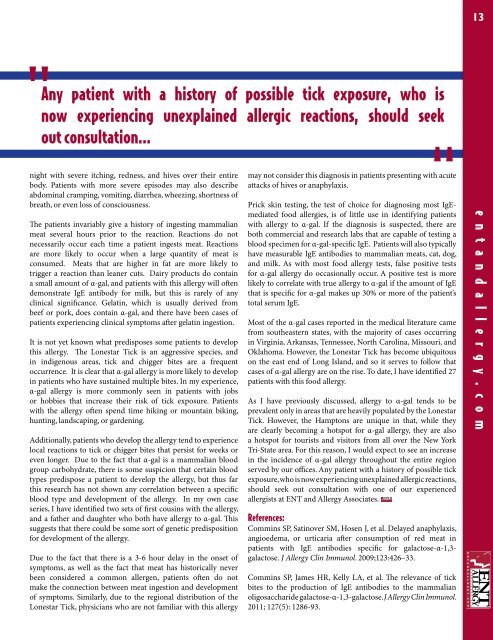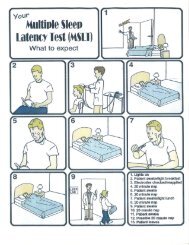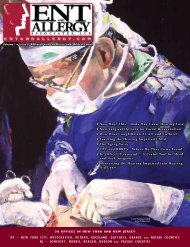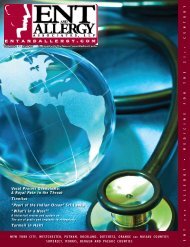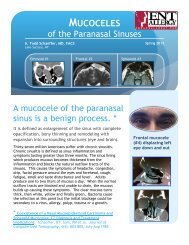ENT and Allergy Magazine Volume I, Issue VIII - ENT & Allergy ...
ENT and Allergy Magazine Volume I, Issue VIII - ENT & Allergy ...
ENT and Allergy Magazine Volume I, Issue VIII - ENT & Allergy ...
You also want an ePaper? Increase the reach of your titles
YUMPU automatically turns print PDFs into web optimized ePapers that Google loves.
13<br />
Any patient with a history of possible tick exposure, who is<br />
now experiencing unexplained allergic reactions, should seek<br />
out consultation...<br />
night with severe itching, redness, <strong>and</strong> hives over their entire<br />
body. Patients with more severe episodes may also describe<br />
abdominal cramping, vomiting, diarrhea, wheezing, shortness of<br />
breath, or even loss of consciousness.<br />
The patients invariably give a history of ingesting mammalian<br />
meat several hours prior to the reaction. Reactions do not<br />
necessarily occur each time a patient ingests meat. Reactions<br />
are more likely to occur when a large quantity of meat is<br />
consumed. Meats that are higher in fat are more likely to<br />
trigger a reaction than leaner cuts. Dairy products do contain<br />
a small amount of α-gal, <strong>and</strong> patients with this allergy will often<br />
demonstrate IgE antibody for milk, but this is rarely of any<br />
clinical significance. Gelatin, which is usually derived from<br />
beef or pork, does contain α-gal, <strong>and</strong> there have been cases of<br />
patients experiencing clinical symptoms after gelatin ingestion.<br />
It is not yet known what predisposes some patients to develop<br />
this allergy. The Lonestar Tick is an aggressive species, <strong>and</strong><br />
in indigenous areas, tick <strong>and</strong> chigger bites are a frequent<br />
occurrence. It is clear that α-gal allergy is more likely to develop<br />
in patients who have sustained multiple bites. In my experience,<br />
α-gal allergy is more commonly seen in patients with jobs<br />
or hobbies that increase their risk of tick exposure. Patients<br />
with the allergy often spend time hiking or mountain biking,<br />
hunting, l<strong>and</strong>scaping, or gardening.<br />
Additionally, patients who develop the allergy tend to experience<br />
local reactions to tick or chigger bites that persist for weeks or<br />
even longer. Due to the fact that α-gal is a mammalian blood<br />
group carbohydrate, there is some suspicion that certain blood<br />
types predispose a patient to develop the allergy, but thus far<br />
this research has not shown any correlation between a specific<br />
blood type <strong>and</strong> development of the allergy. In my own case<br />
series, I have identified two sets of first cousins with the allergy,<br />
<strong>and</strong> a father <strong>and</strong> daughter who both have allergy to α-gal. This<br />
suggests that there could be some sort of genetic predisposition<br />
for development of the allergy.<br />
Due to the fact that there is a 3-6 hour delay in the onset of<br />
symptoms, as well as the fact that meat has historically never<br />
been considered a common allergen, patients often do not<br />
make the connection between meat ingestion <strong>and</strong> development<br />
of symptoms. Similarly, due to the regional distribution of the<br />
Lonestar Tick, physicians who are not familiar with this allergy<br />
may not consider this diagnosis in patients presenting with acute<br />
attacks of hives or anaphylaxis.<br />
Prick skin testing, the test of choice for diagnosing most IgEmediated<br />
food allergies, is of little use in identifying patients<br />
with allergy to α-gal. If the diagnosis is suspected, there are<br />
both commercial <strong>and</strong> research labs that are capable of testing a<br />
blood specimen for α-gal-specific IgE. Patients will also typically<br />
have measurable IgE antibodies to mammalian meats, cat, dog,<br />
<strong>and</strong> milk. As with most food allergy tests, false positive tests<br />
for α-gal allergy do occasionally occur. A positive test is more<br />
likely to correlate with true allergy to α-gal if the amount of IgE<br />
that is specific for α-gal makes up 30% or more of the patient’s<br />
total serum IgE.<br />
Most of the α-gal cases reported in the medical literature came<br />
from southeastern states, with the majority of cases occurring<br />
in Virginia, Arkansas, Tennessee, North Carolina, Missouri, <strong>and</strong><br />
Oklahoma. However, the Lonestar Tick has become ubiquitous<br />
on the east end of Long Isl<strong>and</strong>, <strong>and</strong> so it serves to follow that<br />
cases of α-gal allergy are on the rise. To date, I have identified 27<br />
patients with this food allergy.<br />
As I have previously discussed, allergy to α-gal tends to be<br />
prevalent only in areas that are heavily populated by the Lonestar<br />
Tick. However, the Hamptons are unique in that, while they<br />
are clearly becoming a hotspot for α-gal allergy, they are also<br />
a hotspot for tourists <strong>and</strong> visitors from all over the New York<br />
Tri-State area. For this reason, I would expect to see an increase<br />
in the incidence of α-gal allergy throughout the entire region<br />
served by our offices. Any patient with a history of possible tick<br />
exposure, who is now experiencing unexplained allergic reactions,<br />
should seek out consultation with one of our experienced<br />
allergists at <strong>ENT</strong> <strong>and</strong> <strong>Allergy</strong> Associates.<br />
References:<br />
Commins SP, Satinover SM, Hosen J, et al. Delayed anaphylaxis,<br />
angioedema, or urticaria after consumption of red meat in<br />
patients with IgE antibodies specific for galactose-α-1,3-<br />
galactose. J <strong>Allergy</strong> Clin Immunol. 2009;123:426–33.<br />
Commins SP, James HR, Kelly LA, et al. The relevance of tick<br />
bites to the production of IgE antibodies to the mammalian<br />
oligosaccharide galactose-α-1,3-galactose. J <strong>Allergy</strong> Clin Immunol.<br />
2011; 127(5): 1286-93.<br />
e n t a n d a l l e r g y . c o m


